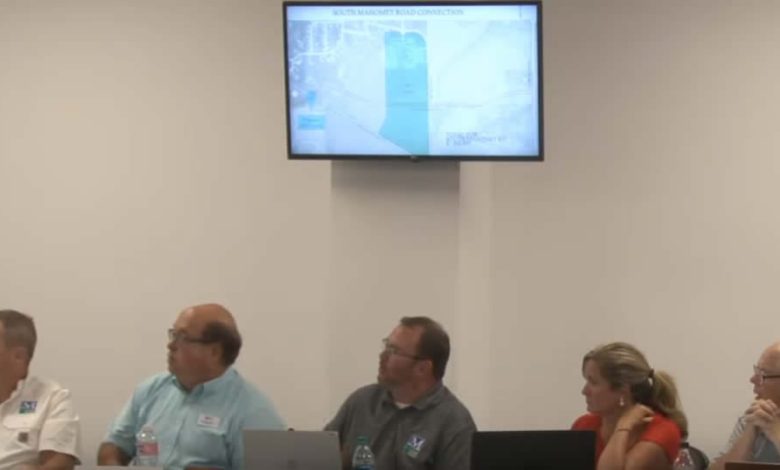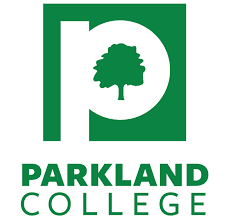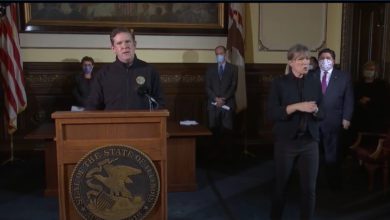Local
Two Mahomet boards learn about TIF district extension

BY DANI TIETZ
dani@mahometnews.com
The Mahomet-Seymour School Board and the Village of Mahomet Board of Trustees got their first look at Village and District staff plans to continue growth within Village limits last week.
Building a new junior high and a community recreation building, with the option of a public pool, will come at a cost to taxpayers, though.
M-S School Board President Max McComb started off the discussion, saying that in 2010 the district decided to purchase nearly 80 acres of what would have been residential development to move two district facilities to the property.
“Being a developer was new to the school district,” McComb said. “In fact, when we started, we did not consider ourselves a developer.”
McComb said that a vision for the property came together through the intergovernmental agreement (IGA), which is still in place.
“That agreement was the most complete document we could write at the time with the information we knew at the time,” McComb said.
Because the property was zoned residential, the District and the Village worked together to develop the intergovernmental agreement, which laid out the district’s obligation to develop Churchill Road through its property as the Village continued to grow.
McComb said over the years, problems have arisen: there is not a funding mechanism in place for the roads, and that the road and the proposed railroad crossing needed to be moved.
“It leaves us with a plan that really doesn’t make sense now,” McComb said.
McComb said that as that agreement needed to be changed, the two entities, not including the boards, met to talk about what the development of the land and the agreements should look like.
To gain insight into the Village growth, the district and the Village joined forces to commission a demographic study that would give projections on population and school enrollment over the next decade. This study was presented to both boards in January.
As of Wednesday (Sept. 4), Middletown Prairie Elementary had 740 students (projected 710), Lincoln Trail had 748 (projected 748), Mahomet-Seymour Junior High had 738 students (projected 746) and Mahomet-Seymour High School had 959 students (projected 956). In total, the district currently serves 3,185 students (projected 3,160).
Per the study, Mahomet-Seymour School enrollments are expected to increase to 3,400 total students in the 2023-24 school year and 3,600 students by the 2028-29 school year before things begin leveling off, according to superintendent Lindsey Hall.
Hall cautioned the audience to keep in mind that as the projections go further out, they begin to become less accurate.
To accommodate the growth, Hall said that classrooms were added at Middletown Prairie and Lincoln Trail Elementary for the 2019-20 school year.
While students in kindergarten through second grade were moved to Middletown Prairie, Lincoln Trail, Mahomet-Seymour Junior High and Mahomet-Seymour High School have seen additions in the last three decades. But all schools are at capacity without the “creative” use of space.
Later in the meeting, during public comment, a grandmother asked Hall to clarify her classroom vision.
“My granddaughter is already in a room that my daughter-in-law says was designed to be a closet. So how much more creative are we going to get?” she asked.
Hall said that was a great question.
“I can’t speak specifically; I don’t know exactly what you’re talking about, but we want students in safe spaces, and places that are supportive and conducive to a positive learning environment,” Hall said.
“There’s probably something else probably in those rooms that’s going to get displaced. It might not be a full-sized classroom, but it might be a related services person or someone in use of that room that’s going to get displaced.
“We still have some ability to combine some of our smaller classrooms, they are not going to be ideal conditions.”
Hall explained earlier that the district, particularly in the junior high and high school settings, has room to have traveling classrooms or teachers that move from room to room based on availability. In some cases, this is already practiced.
Board member Lori Larson said that the district needs to look at the space needs as students in elementary schools move up through the school system.
She said while there might be some extra space at Middletown, the junior high and high school are at capacity, and the district needs to come up with spaces for those students.
Board member Colleen Schultz agreed that the district needs to start the discussion about what they are going to do.
“This discussion feels to me like jumping the gun,” she said. “There’s never been a discussion at the school board level about doing anything with the junior high. At all.
“I feel like we need to start having those discussions before we start making agreements about things,” she said.
Larson added portable classrooms at the junior high would be difficult.
“You don’t want to have your class sizes big, we have contract agreements … so, yes, this is a dialogue that must take place,” Larson said.
Village Administrator Patrick Brown added that the Village growth has slowed down from the 2000 and 2010 census boom, where growth came in at 50 percent. Brown said the Village expects to see 15-percent growth in the 2020 census.
The Mahomet-Seymour School District also serves students in Mahomet Township, Dewey and Seymour, among other rural areas.
Village Planner Kelly Pfeifer said that the Village notified the District of an upcoming residential boom in 2014.
Village Mayor Sean Widener said there is good news in that home EAV continues to increase each year.
“That’s good news for everybody as far as property values and our ability to go after bonding,” he said.
For every tax dollar collected, the Mahomet-Seymour School District receives 58 percent, the County 11 percent, and then the rest is given to other taxing bodies, such as the Mahomet Public Library, the Cornbelt Fire Department, Champaign County Forest Preserve and Parkland College, among a few others.
For those incorporated in the Village of Mahomet, the Village also receives 11 percent of that tax dollar.
Widener explained that the Village has been so focused on commercial growth because it believes the funds to “do things” really comes through the commercial tax base and sales tax.
Widener said that the Village has “already accomplished a lot” in its 2015 Comprehensive Plan, and will make some amendments and new visions to the plan that sets the tone for the Village over the next few decades.
“That’s great news,” he said. “We are moving in the direction of accomplishing goals. But, also, at the same time, it’s an opportunity for the community to come together and reflect on where we’ve been.”
Village growth has happened to the north, south and east recently.
“But if we had an arrow on the direction we are going, it’d be southeast,” Widener said.
With commercial, school and residential development on the IL-150 corridor, Widener said that the Village is experiencing traffic growing pains and congestion at certain times of the day, although in perspective, Widener said that Mahomet does not have a traffic problem.
When Country Ridge was first developed, it was expected to be a main east/west Village street, connecting to Prairieview.
But, the plan changed, Widener said, because the Village could not complete the Country Ridge Drive extension in the timeframe that the school district needed for its development.
At that time, the Village shifted its vision to extending the South Mahomet Road corridor to Prairieview Road.
“I will say this, Country Ridge or South Mahomet Road east/west connection to Prairieview Road has been a focus from the economic development standpoint in the Village for a very long time,” Widener said.
Widener said that the Village has focused its lobbying efforts with Champaign County First on Prairieview Road development for the last three years.
“The Prairieview Road interchange is an underutilized asset that we have in our community, and we want to see that grow,” Widener said.
Widener said that the plans were based on comments prior to 2010 when groups in the Mahomet community called for growth, particularly industrial and commercial growth.
Around the same time that the intergovernmental agreement was completed in 2011, the Village was also in the beginning stages of talking about the Mahomet Area Recreation Center (MARC).
As the Village reached out to residents in 2012, it realized that residents really wanted a community recreation center and a pool.
Trustee Andy Harpst said that he, along with other Mahomet residents, have questioned why surrounding smaller communities have a pool and Mahomet does not.
Harpst said in the 1960s rural communities took advantage of grants for public pools, but Mahomet did not because at the time, they had a “spectacular” swimming facility at Lake of the Woods, with a beach and a waterslide.
“That’s why the other smaller communities have pools,” Harpst said.
With conversations about the original intergovernmental agreement and the need for amendments beginning in 2016, the Village and school district staff came to agreement on what the campus could look like and how the public could use Mahomet-Seymour Junior High, should the district move students to a new facility on Churchill Road.
Widener said that the Village made the right decision not to purchase Sangamon Elementary for a community center because the commercial offices that have moved to the renovated space are “doing awesome.”
By 2017, the Village began talks with the railroad as it looked to add another crossing on the east side of town. According to the Village, the railroad said the Village would have to close an existing crossing on either Center or Walnut street for safety.
Another need in order to see the Churchill railroad crossing to fruition, the Village needs to find a funding mechanism. In 2018, the Village decided to allocate the remaining IL-150 TIF dollars to the railroad crossing. The current IL-150 TIF was established in 2000 and is set to expire in 2023.
But both the Village and school district staff have talked about what it would look like to extend the TIF under the same terms, 100 percent residential pass through and 50 percent commercial pass through to all taxing bodies, for an additional 12 years.
TIF (tax increment funding) was designed to create funding for private or public projects in distressed, underdeveloped, or underutilized parts of jurisdiction so that development may occur where it would otherwise not.
Should both boards, along with other taxing bodies, agree to extend the TIF, the Illinois State Legislature would have to approve the plan.
At the end of the meeting, Mahomet resident Roger Jackson said the TIF district is unique because in typical TIF districts, the local municipality would cap tax dollar allocations and put any increases into the TIF fund for 23 years.
Widener said Wednesday’s meeting was the first opportunity to inform the boards and to include the community in the vision process.
“A lot of the stuff that we have been discussing for a number of years now are really coming into focus,” he said.
“Tonight really represents how things might work. There’s still a lot more legwork to do.”
With the school district’s blessing of a TIF district extension, the Village would gather the necessary funds needed to extend Churchill. Without those TIF funds, the school district would be required to pay for the extension of Churchill Road upon the Village’s request.
Upon the TIF extension, the current intergovernmental agreement will be null and void, relieving the school district of its development obligation.
The Village requires developers to front the cost of road infastructure, water, sewage and drainage upon development.
Schultz asked how a road through the M-S property would affect land use.
“When I see this new plan, I see the campus of the school and I see a road going smack in the middle of it, but when I look at the Comprehensive Plan and I look at the GIS, I see that little Churchill Road and Secretariat coming out that just grazes the bottom corner of the school district road, and then Churchill goes up the side.
Pfeifer said that Secretariat was originally the second access to the development to the west of the district’s property. Without the access, the land is less likely to develop. She said South Mahomet Road would be providing that access as it continues to develop.
Schultz said in the original plan, the school’s property was contiguous, but with this new plan, the property is cut in half.
“And this road is not going to be a side street; this road is going to be a major road,” she said.
“One of the reasons we supposedly got rid of Sangamon (school) was because it was on a busy road. We didn’t want such a busy road near our students.
“I have a real concern about having such a busy road going smack through the middle of where we have our kids every day.”
Schultz asked what initiated the change from the 2016 plans.
Widener said the when the school district talked about Phase II of Middletown Prairie and adding a second building on its property, the question of secondary access arose.
He explained that the original plan was part of the master transportation plan that looked out 30-plus years.
The Village asked, “how can we move the timeline up?” according to Widener.
To the Village, it became clear that the next logical choice was to extend South Mahomet Road.
“And this is what works for that connection,” Widener said.
The development of Churchill Road on the school district is within the TIF district, which would allow it to use the TIF funds for its development and it does not cross private property.
He also said, “Yes, (the road) will be a main thoroughfare, but it’s not going to be an IL Route 150; it’s not going to be a state highway.
He said he expects the road to be busy, much like Division Street.
Trustee Andy Harpst said the speed limit would likely be set at 25 mph.
“So then people would have an incentive to drive down Sunny Acres and just take 150 over?” Schultz asked.
“Sure,” Widener said. “I wouldn’t say incentive, I would say choice.”
Village board member Merle Giles said that the cost of the road through the district property is less than what was originally planned.
Plans for the new road direction or the TIF extension have not been discussed in public session. Schultz said in preparation for the meeting, she asked the Village for documents of public meetings or meetings between the Village and district staff, but her FOIA request was denied based on the Village citing the discussions were preliminary.
Hall said that she has always made herself available for Schultz.
Schultz said that she had asked for all the background information from Hall prior to the meeting.
Should all go as planned, Widener said that approval for the east railroad crossing should happen by 2021, and in 2022 South Mahomet Road will be connected with Churchill Road. Then within the next year, Churchill will be connected to Prairieview.
“Our vision is that the TIF district extension will be able to fund improvements,” Widener said.
Both entities hope that the change will help ease IL-150 congestion.
By 2024, the school district could move Mahomet-Seymour Junior High to Churchill and the new intergovernmental agreement would give the Village the right to purchase Mahomet-Seymour Junior High, Middletown Park and Middletown Soccer Field for $750,000.
With the purchase, the Village would also take possession of 13 Acres Park.
The Village would tear down much of the Mahomet-Seymour Junior High building, leaving the athletic facilities and add a public outdoor pool on the property.
The Village expects the MARC building to cost $10 million. The Village plans to look into private donations, but also said the taxpayers would have to vote for a tax increase to make the building happen.
Board members Larson and Giles asked if the MARC would be something both the schools and public could utilize.
Dan Waldinger, from the Parks and Recreation Department, said that in the spirit of collaboration, the facility could be utilized, but added that part of the reason the Village has been so stretched is because of lack of community space.
When the Mahomet-Seymour High School Fieldhouse was built, it was pitched as a community space. With school district athletic teams using it year-round, availability has become limited.
Larson said it’s no secret that there has been dissatisfaction with that.
Widener said if the Village could not move forward with the purchase of the junior high, for whatever reason, it would still retain ownership of 13 Acres Park, but would reimburse the school district for $225,000, although that amount is still under discussion, according to the Village president.
Once the new intergovernmental agreement is established, the Village will take possession of 13 Acres immediately. Much like Taylor Field, the Village is looking to make improvements to 13 Acres Park, but cannot do so without ownership of the property.
In a phone interview, Brown said that an appraisal was done on 13 Acres Park at over $350,000, but that estimate was for optimal development, not park use.
McComb said 13 Acres makes much more sense for the Village than it does for the school district.
With the Mahomet-Seymour School District still making payments on bonds issued for both phases of Middletown Prairie Elementary, the school district will also need to turn to taxpayers on the ballot to have funds for a new building.
District staff has talked about building Mahomet-Seymour Junior High on its east campus, but the board has not discussed the issue publicly or voted on the issue.
Mahomet resident Katy McCue asked why the district would sell the junior high, knowing that the high school was at capacity.
Hall said she wanted to offer clarity between not having empty classrooms versus still having classroom space.
She said currently, all classrooms are occupied by a teacher.
“There are times during the day, though, when those teachers are not teaching in the classroom and it is not full of students because it’s the teacher’s plan time,” Hall said. “So we can still add staff, but additional staff are going to have to travel to different classrooms to teach.
“It’s not ideal, but it’s also not uncommon.”
Hall also said the junior high is in a similar situation.
Originally built in the early 1960’s, Hall believes that the space would take a lot of investment and work for the district to continue to use.
“There does come a time when school districts have to ask themselves what’s the return on investment for investing a lot of dollars into an older building that’s overcrowded.”
Giles said that the incentive to do this project is to accelerate commercial growth, which will benefit all taxing entities.
“I see it, from our perspective, the school district giving that 50 percent is a good trade for getting this developed early,” he said.
M-S board member Meghan Hennesy, who joined by phone, asked what dollar amount the school district loses in the 50 percent that is put into the TIF fund.
M-S School District Financal Officer Trent Nuxoll said he did not have the figures and would provide the information later.
Schultz asked about the benefits of extending a TIF over making a new TIF district within that area.
Widener said the Village had an obligation to the current TIF. He added that the Village goals within that TIF had been accomplished, and by creating a new TIF, the tax dollars would be captured for 23 additional years rather than 12.
Hennesy wanted to know the acreage split with the road.
McComb said it hadn’t been calculated, but that it was about a 60/40 split with 30 acres on the south side and 40 acres on the north side.
Hennesy asked if the school district did not agree to the parameters, if the Village would continue to extend the TIF.
Widener said, “I don’t think we have any interest or potential projects of this nature that would warrant us to extend the TIF.”
All taxing bodies have to agree to the terms of the TIF prior to the development of or extension of the TIF. Brown said without that consensus, the state legislative body would not approve the measure.
“If we don’t extend it, that’s fine,” Widener said. “We have other priorities, trust me, that we will focus on. I think that would be counterproductive to what we are trying to achieve together.”
Schultz said she is not opposed to working together and having discussions, but that the meeting was the first time the board had been apprised of the issue.
“We have to slow down and take it all in,” Schultz said.




